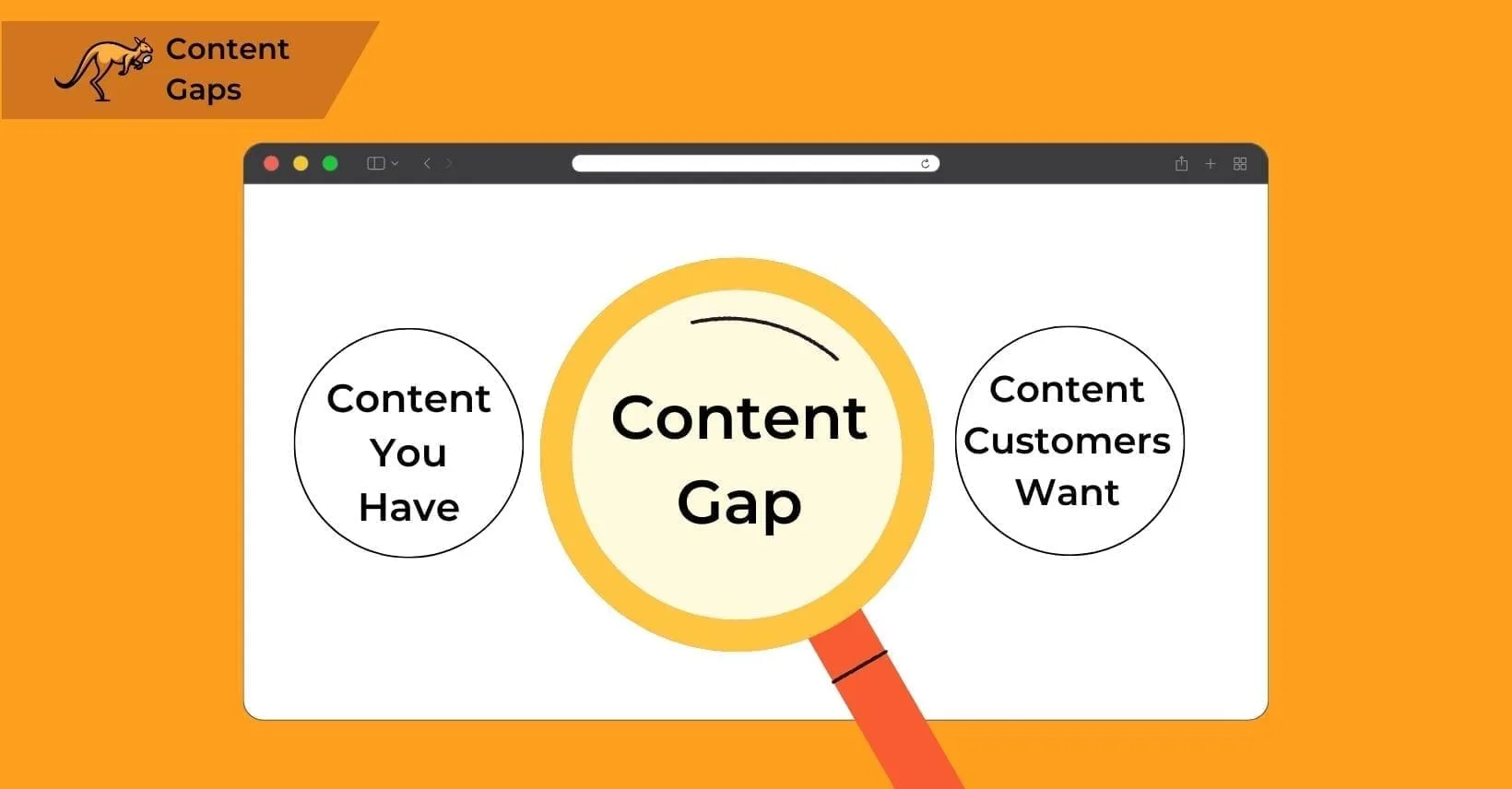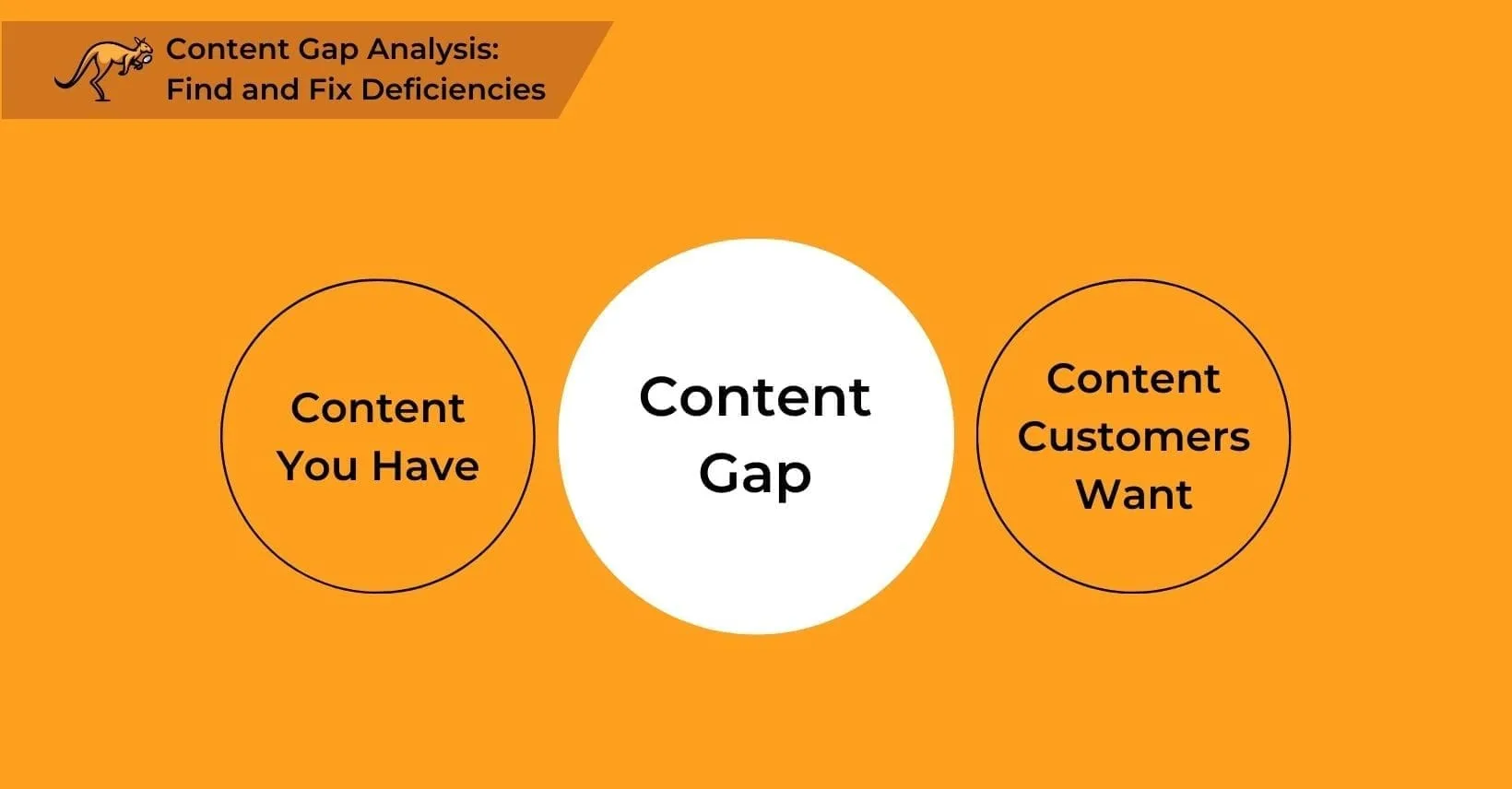Creating content for your website is a key part of marketing, but it isn’t always easy. Regardless of how much content you have, there will always be a gap that needs attention. Filling these gaps is vital.
Content gaps reveal missed keyword opportunities that allow competitors to overtake you in search rankings. Addressing these content gaps strengthens your SEO strategy by claiming valuable search territory before competitors can capitalize on it, which directly improves your organic visibility and traffic. Recognizing these gaps helps you stay ahead, and understanding their impact is the first step.
What are Content Gaps?

A content gap is a missing piece in your content strategy. It could be a keyword you’ve overlooked or a topic not covered on your site. When users search for something and can’t find it on your site, they turn to competitors. Competitors rank higher because they provide what your site lacks.
To fill these gaps, create content that covers a wider range of topics users seek. This doesn’t mean diving into irrelevant areas. For instance, a furniture company could target keywords from bedside tables to lampshades, covering a broad spectrum. Filling these gaps is essential for staying relevant and competitive.
So, understanding the importance of addressing these gaps can make a significant difference.
Why Is It Important to Fill Content Gaps
All the keywords your business targets form the core of your marketing strategy. You benefit from these targeted keywords, but related keywords that are not targeted may miss potential benefits.
Your content only appears to those using relevant keywords, but your audience might not use those terms or seek that content type. Effective content creation means appealing to many people and using new content ideas to attract new audiences.
Search intent varies. Someone searching “desk chairs” finds your article on desk chairs, but someone searching “home office furniture” might not. Filling content gaps involves identifying overlooked areas and capitalizing on untapped sources of potential customers and organic traffic.
Creating blog posts and other content to fit these gaps draws in users who might otherwise miss your search engine results. Content gap analysis provides measurable benefits including expanded audience reach, increased organic traffic, improved keyword rankings, enhanced user engagement, and prevention of competitor advantage. As we explore this further, it becomes clear why identifying these gaps is crucial for expanding your reach.
Understanding Content Gaps
Generally, there are three content gaps to consider: media, topics, and keywords. Each impacts your business differently and may require unique strategies to address.
Topic Content Gaps
Topic gaps are often the first content gap that comes to mind because they are the most straightforward. In a topic gap, the focus is on the topics themselves, specifically whether your site targets every possible topic in every possible way.
Content isn’t a simple yes-or-no choice; there are various nuances to what it can be. Sometimes, effective content marketing doesn’t even revolve around a completely new topic.
There are four core questions to ask when considering these gaps in your content:
1) Does my site’s existing content cover every topic your intended audience would care about?
2) Have you already completely covered every topic that would be relevant to your readers and capture their interest?
3) Does your site cater to all levels of comprehension and reading skills for all readers in all contexts that would be relevant (such as beginners and professionals looking for different kinds of articles)?
4) Is your target audience always finding the article they want when they click on your business in search results?
If any of these questions return a “no” answer, then you probably have a gap in your content that needs to be filled before a competitor can overtake you.
Media Content Gaps
Media gaps occur when video content is lacking on your website or in your marketing efforts. Whether through paid ads or SEO, video content has become a popular and effective advertising tool.
Incorporating media into your content plan can significantly boost brand awareness, traffic, and sales. Still, it must be executed properly to be effective. Without quality video content, you risk falling into a major content gap, missing out on engaging almost three-quarters of your target market.
Video content holds substantial potential even in niches like funeral care or medical services. Ignoring video content and other media forms can greatly hinder your SEO campaign’s success.
Identifying and addressing these media gaps can lead to discovering keyword content gaps, further unlocking opportunities for enhancing your strategy.
Keyword Content Gaps
Keyword gaps focus on your target keyword choices. Keywords don’t follow a strict good-to-bad scale. Some less optimal keywords may offer higher click-through rates or target a necessary niche. Long-tail keywords, part of larger phrases, are less used by outsiders but more by customers seeking a product or information.
Ignoring keyword choice can create content gaps. Consider your audience’s search intent. Specific keywords attract informed potential customers. Niche keywords mean less competition, as fewer businesses target them. This requires time and market research, but the results are worth it.
To close these gaps, understand where your content may be lacking.
How to Identify Content Gaps
Fixing content gaps requires knowing where these gaps exist in your current content. The best way to identify them is through content gap analysis. But what exactly does content gap analysis entail, and is it crucial if you’re already busy with other market research tasks? These are the things you can do to identify content gaps.
What is Content Gap Analysis?
While the idea behind a content gap analysis can sound daunting, it is easiest to perform with dedicated content gap analysis tools.
In simple terms, a content gap analysis is the systematic process of identifying missing topics, keywords, or media formats in your website’s content strategy that could attract more visitors and improve rankings. Content gap analysis examines your content marketing strategy to discover areas where you can create new content or capture additional audience segments, helping you stay competitive in search results.
Tools like Google Search Console, Ahrefs, SEMrush, Moz, Ubersuggest, and other specialized SEO platforms allow you to partially automate content gap analysis, making it much easier for your overall SEO workflow by providing competitor keyword data, search volume metrics, and ranking opportunity insights.
Running a Content Gap Analysis
While the idea behind a content gap analysis can sound daunting, it is easiest to perform with dedicated content gap analysis tools.
In simple terms, a content gap analysis is the process you use to identify content gaps directly by examining your content marketing strategy and identifying areas where you can still create content or capture a new audience.
Performing a content gap analysis involves several steps: auditing your existing content, researching competitor keywords, analyzing search intent for your target audience, identifying missing topics or formats, and prioritizing gaps based on potential traffic value. A typical content gap analysis tool allows you to scan your domain for obvious keyword gaps, which can take longer depending on how many keywords you currently use.
When used alongside a decent keyword research plan, this content audit can help you highlight areas where your content is not appearing or connecting with users.
From there, you can focus on the top-performing keywords and find ways to build new content that matches them, filling that content gap with new ideas.
Auditing Customer Journey Information
A content gap is not always as obvious as an empty pit ready for content creation. The buyer’s journey can also matter.
The buyer’s journey – the path users take from a Google search onto your site – can reveal areas where quality content would help.
For example, the buyer’s journey might show that all users reach the same landing pages, regardless of their search. This might mean that sales pages are not appearing in the right places or that there is insufficient content to create multiple touchpoints for their journey.
You can often find gaps by looking at how the customer journey pans out and their behavior on your site.
Suppose you are finding it hard to get users into your sales funnel. In that case, it might be because no blog posts or FAQ pages answer the question they are looking up, so they have no reason to visit your website in their customer journey.
Auditing Your Content
A simple content audit can help.
Content gap analysis is all about trying to identify gaps, and sometimes, you can simply spot missing content or important keywords by looking at your pages for yourself.
Broken links, a lack of top keywords, or even poor meta descriptions and meta title tags can all be signs that content is not fulfilling its role.
If you type something related to your business and are not even on the first page of results, there is room for improvement.
This can also happen after major changes to your business.
For example, you might have more content gap issues if you introduce new products or services.
There is not enough content about those topics yet, but many users may want to look them up.
Copying Competitors
Look at your competitors’ keywords and use them to your advantage. Identify content gaps in your industry’s search results by analyzing SERP features, examining top-ranking competitors’ content structures, and noting which queries return limited or unsatisfactory results within your niche. Suppose a competitor recently did keyword research and a market survey. In that case, they will likely change their keyword choices based on their findings.
Break down their SEO tweaks and adapt them for your pages using original content assets to stay competitive. Avoid duplicate content to prevent potential issues from arising.
Let’s explore how addressing a content gap can further boost your strategy.
Fixing a Content Gap

After identifying a content gap through analysis, the simplest solution is to fill it directly. Filling content gaps requires creating high-quality, targeted content that addresses specific user needs while incorporating relevant keywords and appropriate media formats based on your gap analysis findings. This involves creating new content to occupy the “empty space” and seize missed opportunities. For optimal results, ensure your gap-filling content meets several key criteria:
Different From Existing Content
Never simply copy a blog post and reword it slightly to fill a content gap.
A good content marketer will create new pages for each niche.
This not only makes it easier to accidentally produce top-performing pages, but it also ensures that search engines do not penalize them.
Clickable and Interesting
You ideally want to make your content the first page that users will decide to click on.
While this is impossible, you still want to capture attention on the search engine results page.
Your content needs something that makes users want to click, from an interesting header to an answer to their query.
Worthwhile and Appealing
Content gap analysis shows where to place new content and what should be focused on.
Always produce content that has value to it, rather than just empty shells full of keywords.
Even if this does not necessarily give it more SEO power, it makes it more useful to users.
This increases their appreciation and awareness of your brand and might even make you an authority on that topic.
If users visit your content gap analysis filler content and find nothing but bland bullet points and AI-generated fluff, they will be much less likely to visit your site again.
Relevant to User Interests
Relevancy is key after every effective content gap analysis.
Even if competitor analysis hints at keywords with a high search volume and excellent ranking page potential, make sure they are relevant.
There is no point chasing a keyword with a huge search volume if it is irrelevant to your business.
Remember, SEO is not just about quantity but also quality.
A hundred articles about random things unrelated to your business will not be as powerful as twenty articles closely tied to your products and services.
Simple and Targeted
Don’t clutter your content with too many details. A content gap focuses on one or two related topics. Trying to address every gap on a single page leads to a mess of information users might ignore.
Providing a clear and concise answer often secures a user’s attention. For instance, if a user seeks safety measures for a product, list those measures directly instead of hiding them in a press release.
To fully bridge these gaps, consider experts’ strategies for pinpointing and resolving content deficiencies. Understanding how professionals approach this can make all the difference in refining your content.
How SEO Agencies Help You Address Content Gaps
SEO agencies help you address content gaps by identifying areas where your content is lacking or missing. Content gap analysis fits into your overall SEO strategy as a foundational element that informs content creation, keyword targeting, and competitive positioning while complementing technical SEO, link building, and user experience optimization efforts. They analyze your existing content, compare it with competitors, and pinpoint the topics and keywords that need more coverage.
By doing so, they ensure your website meets the needs of your target audience and ranks higher in search engine results. These agencies create targeted content strategies, produce high-quality material, and continuously monitor performance to fill those gaps effectively.
This approach enhances user engagement and drives more organic traffic to your site, improving your overall online presence.
Why Choose Searcharoo as Your Trusted SEO Partner?
Choosing Searcharoo as your trusted SEO partner offers numerous benefits. Our team of experts excels in identifying and addressing content gaps, ensuring your website consistently delivers valuable and relevant information to your audience.
We analyze your competitors and industry trends with a data-driven approach, providing tailored strategies that enhance your online visibility.
Our commitment to quality content creation, high-ranking keywords, and continuous performance monitoring ensures your site remains competitive in search engine results.
Our personalized service, industry expertise, and proven track record make us an ideal choice for businesses looking to boost their online presence and achieve sustainable growth.
Additionally, we offer comprehensive SEO services, from technical audits and link building to content optimization and analytics, providing a one-stop solution for all your SEO needs.
By partnering with us, you gain a dedicated team focused on driving organic traffic, improving user engagement, and ultimately increasing your conversions and revenue.
Final Reflections: Bridging Content Gaps
As you have probably learned by now, content gaps are a problem, but they are solvable.
While it might take some time, there are plenty of ways to recapture the potential you have lost or draw in the audience you forgot to target.
Just remember that there is no wrong way to tackle this problem. Adapt your strategy, change your content, and be prepared to rework things if the content you create does not work as expected.





